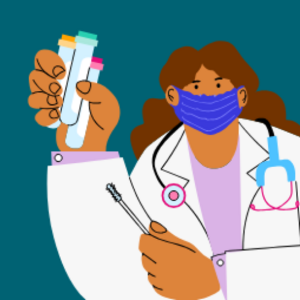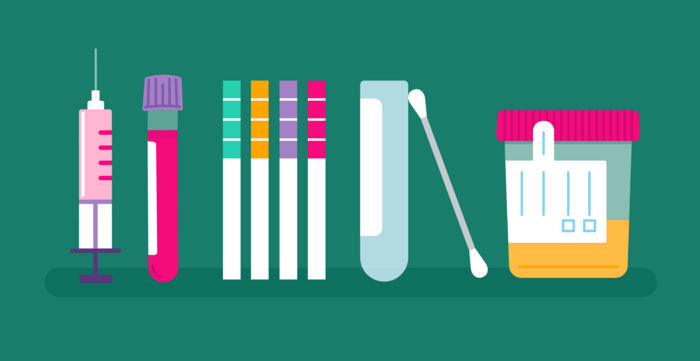
Ensure your health. Get tested today.
Convenient lab testing at your fingertips at more than 5,000 locations nationally. Consult with a doctor, or get tested on your own.

Drug tests are tools that can be used to identify the presence of specific substances in a person’s body, such as illicit drugs of abuse or prescription medications. Employers often use drug tests to screen potential hires or to routinely monitor their employees. Healthcare providers often use drug tests to make sure that a patient is taking the drugs they’re prescribed or to assess patients who are acting erratically. Law enforcement bodies, sporting organizations, and educational institutions may also use drug testing. Outside of large institutions, drug tests may also be used on a personal basis to monitor a family member or other loved one.
Drug tests are performed in different ways, including urine tests, blood tests, hair tests, saliva tests, and even sweat tests. Urine drug tests are most commonly used by healthcare facilities, but a blood test may be ordered in some circumstances. Tests that analyze saliva, sweat, and hair follicles can also be used, but their consistency can vary.
Every drug test has a specific cutoff limit. This means that a minimum amount of a drug must be present in a person’s system for the test to be interpreted as positive. According to SAMHSA, beneath the cutoff limit, the drug test is considered to be a negative test. This means that you technically could have a small amount of a substance in your body and still have a negative drug test. For a urine drug test, the cutoff limits are measured in nanograms per milliliter (ng/mL). If the amount of drug present in the urine is beneath a lab test’s given threshold (for example, beneath 300 ng/mL for morphine), then it will be considered by the lab to be a negative test and reported out as such, according to the Substance Abuse and Mental Health Services Administration (SAMHSA).
The amount of time that a drug can be detected within your system varies from person to person and, according to experts at the Mayo Clinic, it also depends on the drug itself, the way that the drug was used (i.e., inhaled or injected), how heavily the drug was used, and a specific lab’s cutoff threshold. Drug detection times often depend on the type of drug test being performed — for example, drugs are faster to disappear from the urine than from a hair follicle. In general, drugs are metabolized (and become undetectable by drug testing) within a few days. However, some drugs — such as marijuana — can be detected for weeks after use.
The most common type of drug test used by employers and other official agencies is a urine sample drug test. Urine samples provide fast and efficient drug screens, without subjecting a person to a blood draw.
According to SAMHSA, any substance that is ingested or inhaled to the point that it reaches the bloodstream is eventually filtered out by the kidneys and then routed to the urine. Most drugs can be detected in the urine for a few days following ingestion (though there are exceptions — some drugs take a lot longer to clear the urine), so they may be in a person’s urine even after the effects of a drug have worn off. Two main types of urine sample drug tests are used — a 5-panel test and a 10-panel test. Both urine tests screen for the most commonly abused drugs, but the 10-panel test is more comprehensive.
The amount of time that drugs can be detected in the urine varies based on the drug, a person’s metabolism, the dose, the drug’s half-life, and other factors. However, in general, the range is from 1 to 3 days, according to a report in Mayo Clinic Proceedings. Some outliers include phencyclidine and benzodiazepines, which can be detected up to 30 days in the urine of heavy users, and marijuana, which can be detected in the urine for months after heavy use.
Depending on the type of drug panel (a 5-drug panel or a 10-drug panel), a number of substances may be screened for in a urine test.
Alcohol, or ethanol, is present in beer, wine, and hard liquor. Some employers will use a urine test to screen for the presence of alcohol if there has been a job-related incident. According to Mayo Clinic Proceedings, alcohol is metabolized very quickly in the body, so it would generally only show up if it was consumed within the 12 hours preceding a urine drug test.
Amphetamines such as speed and meth can be detected using a urine drug test. According to SAMHSA, some over-the-counter cold medications, such as decongestants, can cause a false-positive amphetamine result. Amphetamines can generally be detected in the urine for 48 hours.
Benzodiazepines are often prescribed to manage anxiety conditions, but they have other clinical uses, too. They can also be abused as street drugs. The detection of a benzodiazepine is highly dependent on its formulation. Short-acting forms, like Xanax, can be detected in the urine for 3 days. However, long-acting forms, like Valium, may be detectable for 30 days, according to SAMHSA.
Marijuana’s detection on a drug test is heavily dependent on the amount consumed. According to SAMHSA, after a single use, it may only be detected for three days. However, after chronic use, it may be detectable in the urine for more than 30 days. Some people wonder if CBD shows up on a drug test. Technically, pure CBD should not show up on a drug test because drug tests screen for the intoxicating component of marijuana, which is known as THC. However, because CBD is not regulated by the FDA, it can be hard to be assured of its purity.
Cocaine is a stimulant drug that is derived from the coca plant. It can carry the street names of blow, bump, coke, and crack, among many others. Cocaine is commonly screened for in urine drug tests. According to SAMHSA, Cocaine can be detected in the urine for two to four days.
Opiates are depressant medications that have a variety of clinical uses and can also be abused for their euphoric effects. Different formulations of opioids have different detection thresholds and detection times. Heroin can be detected for 48 hours in the urine, whereas oxycodone may be detectable for an additional two days, according to SAMHSA. Eating poppy seeds can sometimes cause a false-positive result.
Phencyclidine, also known as PCP, is a hallucinogenic drug. According to SAMHSA,Phencyclidine can be detected in the urine for up to eight days. A common cough medicine, dextromethorphan, can sometimes create a false-positive result.
Workplace drug testing is very common. Many employers screen their potential hires, particularly if they are in an industry where they will be taking care of other people (such as healthcare) or if on-the-job safety will be a primary concern (such as construction or truck driving). Some employers may also have their employees undergo routine drug testing to ensure that they are adhering to a substance-free lifestyle, and some may subject employees to random drug testing.
Some of the reasons that a person may use a drug test include personal curiosity, monitoring of a family member or loved one, a medication monitoring agreement, a legal issue, or for employment.
If you are in need of a drug test, for employment reasons or otherwise, Solv has made the process quick and convenient. Visit our handy drug test finder tool to find a drug test near you. Depending on the type of test needed, your results may be available within the same day.
The different methods of drug testing include urine tests, blood tests, hair tests, saliva tests, and sweat tests.
The cutoff limit in a drug test refers to the minimum amount of a drug that must be present in a person's system for the test to be interpreted as positive.
The detection time for drugs varies based on the type of drug, how it was used, the frequency of use, and the type of test being performed. It can range from a few days to several weeks.
No, drug tests are used by a variety of institutions and individuals, including healthcare providers, law enforcement bodies, sporting organizations, educational institutions, and even family members monitoring a loved one.
Yes, if the amount of the substance in your body is beneath the test's cutoff limit, the drug test can still be negative.
Your hair is a very slow-growing part of your body. Unlike blood and urine, which eliminate drugs from your body after a few days, your hair can retain evidence of drugs for up to 90 days in the past, according to data from SAMHSA.
Even if you fail a drug test, the results will be kept confidential because of health information privacy legislation, according to the SHRM. However, if you have taken a drug test for a pre-employment screening, or as part of a mandated screening from your employer, it is up to your employer to determine the next steps. Often, a confirmatory test can be ordered, or the test can be appealed to a medical review officer. This is especially important if you believe you may have had a false-positive result.
If you’ve wondered if there is a drug test near me, you’re in luck. You can choose from a number of places to get a drug test. One of the most efficient, convenient, and affordable ways is by visiting a local convenient care location. At Solv, we offer drug testing services at our urgent care locations nationwide. Our providers have a seamless process that can have you out of the office in under 30 minutes, armed with the information you need.
If you have a false-positive drug test, it may be because of a prescription medication that you are taking or because of a specific component of your diet. According to SHRM, it's important to follow up with your healthcare team right away so that you can have a repeat test. If something in your daily routine may have caused a false positive, a more advanced test may be ordered for confirmation.

Convenient lab testing at your fingertips at more than 5,000 locations nationally. Consult with a doctor, or get tested on your own.